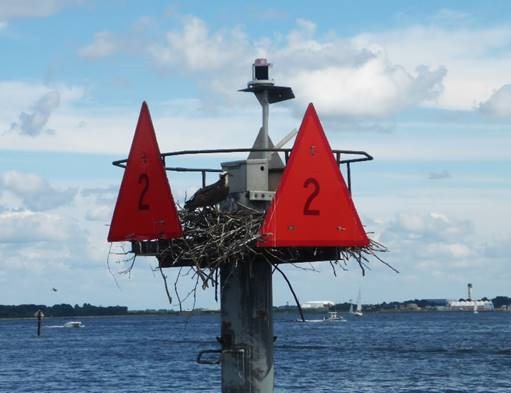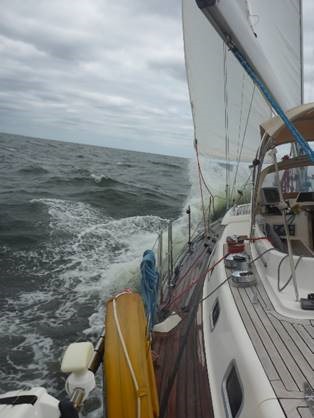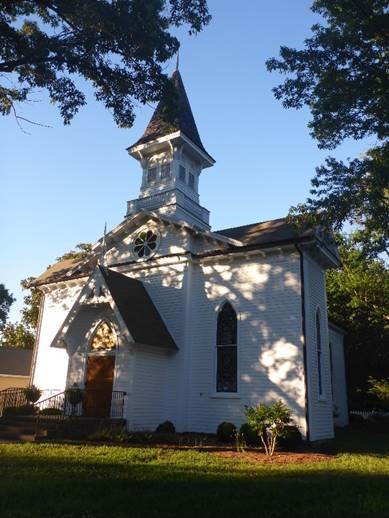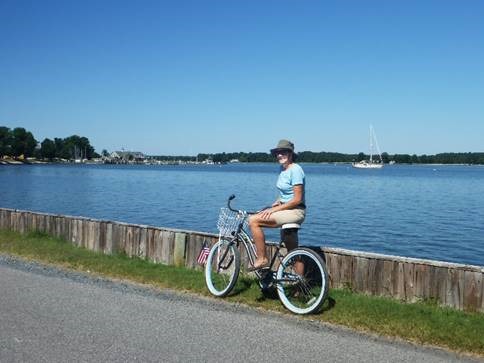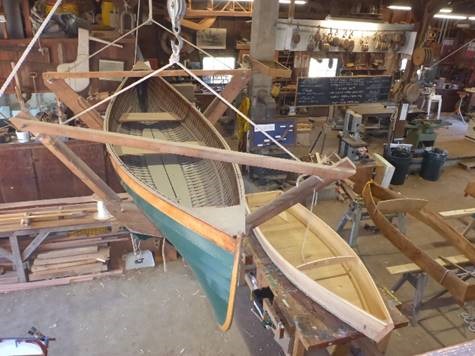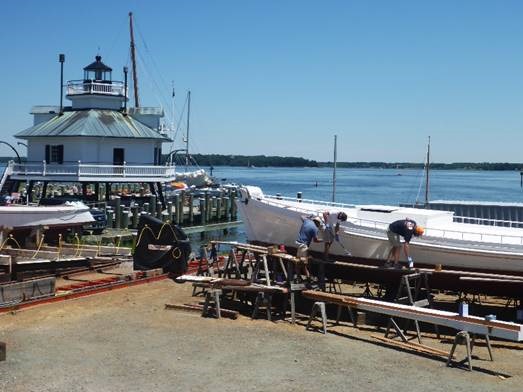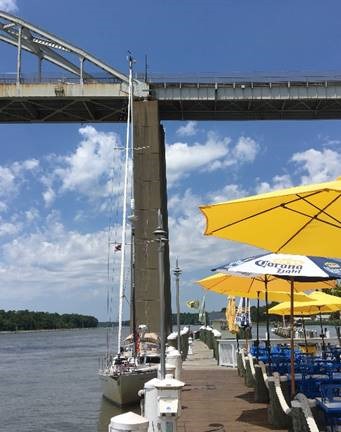13 July - at the top end of the Chesapeake

|
39:35N 075:34.5W
I hear there’s a new Osprey living at No 2? The passage from Reedville to Solomons Island was remarkable only because we had some decent wind for the first time since we left Charleston a month earlier. Somebody once told me that we might end up motoring around the world rather than sailing; up until recently we have sailed everywhere. The eastern seaboard of the US seems to be light on wind at this time of year – it must be blowing elsewhere on this vast continent!
Pound net complex in the Chesapeake Needless to say, the wind was on the nose so we ran the engine for longer than usual to ensure that there were no residual problems (none so far) and to give the batteries a good charge. The perennial challenge for a European boat sailing in North American waters is the voltage difference. I’m on the lookout for a reasonably lightweight, portable transformer that turns 110V 60Hz into the standard used across the overwhelming majority of countries around the globe: 220V at 50Hz – with a connection that won’t leave our insurance company rolling about with laughter when the whole thing catches fire! There’s a simple but expensive solution, which is to upgrade our nice little Victron battery charger into one that copes with the full gamut of inputs, but so far I’m resisting the urge to spend the money…
Heading north up the Chesapeake… under sail for once! Solomons Island lies at the mouth of the Patuxent River and is well known as a cruising boat destination. It was our first visit by boat to Maryland and whilst we did not detect any obvious changes from Virginia, it was clear that this is an affluent area. After the peace of Reedville it was busy with yachts and powerboats as well as oystermen and tugboats waiting to assist the big bulk carriers and barges we were seeing out on the Chesapeake. The land is pretty flat, but for the first time since entering this huge bay a month ago we could see land on both shores as we sailed north. At Solomons we sailed past the smart-looking marina complex and small town at the mouth of the inlet and followed our noses into the upper reaches of Mill Creek. Here, the size of the waterfront homes matches the boats on the docks and it was clear that this is pretty exclusive territory - a weekend escape for the Swamp dwellers of Washington DC or the merchants of Baltimore. We didn’t venture ashore, but instead tried out the new propane gas canisters on our little Magma barbeque as the wind dropped and the sun set. Splendid!
Typical waterfront homes in Mill Creek, Solomons MD The following morning, the wind once again deserted us and we motored the next fifty miles or so across the Bay to Oxford on the Eastern Shore. What wind there was, was right on the nose, but at least it kept the temperatures manageable in the low-90s. More yachts than further south, but more crab pots too. In the shallowest water, fishermen dispense with pots and set a long line of baited hooks, which they then patrol with a small handling net. Much like small children crabbing on the pier at home, they lift the line and catch the greedy crab in the net before he has the sense to let go of the bait. I wonder that any crabs survive, given the intensity of the fishing; indeed we learned that up to half the crabmeat consumed so voraciously by diners in this part of the US might have come from the Far East. And one consequence of current immigration policy in the US is that local fishermen are finding it hard to recruit anyone to pick the crabmeat from local Blue Crabs – fewer African Americans want to do it and the migrant South American pickers are not coming. Prices are rising… I wonder whether we will see a similar problem in the UK in the near future?
An Oxford MD spire Oxford is beautiful. Not as many dreaming spires as our famous University town, but some fine, classic Colonial architecture, leafy streets, immaculate boatyards and a sleepy, satisfied feel to the place. We anchored off The Strand in the Tred Avon River, close to the yacht club and the ferry across to St Michaels. As with everywhere else on the Chesapeake, the shoreline is made up of an endless succession of pretty creeks inviting exploration – but more often than not we found that the water is too shallow for Escapade. A trawler yacht with a couple of big diesels would be an ideal vehicle for exploring these waters in comfort, or a lifting keel ‘sailboat’ such as the Hinckley (an American Swan?). Here, we were keen to visit St Michaels, a town just five miles away as the crow flies, but nearer fifty if we went by water. We asked the local OCC representatives about bicycle hire and got the usual, enthusiastic response from Jim Robfogel and Mark Pellerin: the US membership of this organisation are brilliant at supporting cruising yachtsmen visiting their shores and making us feel really welcome.
Julie on her trusty treader, with Escapade at anchor in the Tred Avon River behind So on Monday 9th we took fuel from the marina and hired bikes there too. We caught the quirky little car ferry across the harbour and cycled through rural bliss to the town of St Michaels. It’s far more touristy than Oxford and much bigger; we cycled past the usual collection of car showrooms and air conditioning companies on the way into the main town, which is an attractive, immaculate place with more than its fair share of shops selling things you never knew you needed, restaurants, art galleries and ice cream parlours. Not really my thing, but the jewel in the crown is the Chesapeake Bay Maritime Museum (CBMM).
The ‘working shipyard’ at CBMM. Reminds me of Boathouse No 4 at Portsmouth Dockyard (which houses the International Boatbuilding Training College). Here, the summer camp projects are on the right. It sits across some fine waterfrontage on the Miles River and occupies what was once a working boatyard and fishing dock area. They have a fine collection of traditional Chesapeake working boats from the last 150 years or so, some being restored, most of the larger ones afloat and all of them interesting in one way or another. They were running a combined sailing and boatbuilding summer camp for children – presumably quite wealthy kids as they get to take the little rowing skiff home at the end of the week – and the quality of the woodworking in the yard was very high. The oyster fishing display was based around a fine skipjack sailing dredger in a shed and we got a sense of the scale of the business which employed huge numbers of people at sea, on the waterfront and in the canneries. There is an old ‘screwpile’ lighthouse ashore here; funny to think that the Chesapeake used to freeze over each winter and the ice floes were big enough to uproot these structures… The other fascinating display covered ‘waterfowling’. Now largely illegal, it explained how hunters developed sophisticated killing machines and decoys to harvest ducks and geese in industrial quantities up until the 1930s. Eventually, someone realised that Man was upsetting the natural balance of this wonderfully rich marine environment. I wonder if they’ve gradually forgotten that lesson again?
Restoring an oyster dredger, with the screwpile lighthouse to the left The area around Oxford and the Tred Avon River is one of those places where we could have stayed quite happily for a few days, but we were now on a schedule to reach New York by the weekend. So on Tuesday we sailed north to the Sassafras River, just short of the Chesapeake and Delaware (C&D) Canal. The passage took us past Annapolis on the western shore and under the Chesapeake Bay Bridge. North of here, the amount of water for sailing boats of a certain draft starts to narrow quite quickly and we were never that far from the main dredged channel. There were a handful of big ships anchored south of the bridge, probably waiting to enter the port of Baltimore, but the only thing that bothered us was the amount of dead fish floating in the water. These were quite sizeable, adult fish. I wondered whether the unusually hot weather had affected them (perhaps killing their food supply), but I think that something nasty had got to them as the seagulls were not interested in them. Plenty of fishermen were trying to catch live ones, so I just hope that whatever it is has not entered the food chain in Maryland… Perhaps the ever-enthusiastic Marine Police who seem focused on whether rubber dinghies are more than liferafts or have registration numbers might switch their attention to a potential pollution hazard?
Barge and pushing tug on the C&D Canal We planned to watch the England-Croatia World Cup match at Betterton on the Sassafras River, but when we got there we found that it was a tiny little place without the ubiquitous sports bars and almost no mobile phone signal. So on Wednesday morning we pushed on into the Canal and stopped at Schaefer’s Canal House at Chesapeake City for lunch and football. They were a friendly bunch but it would be fair to say that they weren’t much interested in ‘soccer’. The outside bar had a fine view of the canal and the bridge and the food wasn’t bad at all. A couple of passers-by, looking at the port of registration on our stern, thought that the boat was a long way from Ipswich in Massachusetts or Connecticut (where I gather there are towns with the same name) – they were quite surprised when I invited them to identify the flag flying right next to the word ‘Ipswich’. ‘Oh… (penny dropping)… So you came all the way from England, then?’ Well, I suppose we could have put the thing on a transporter.
Escapade alongside in the C&D Canal The canal is only twelve miles long, so after the football finished we got under way and an hour or so later emerged into the Delaware River. It’s wide – and pretty shallow – but we tucked ourselves in just to the north of the canal entrance and anchored for the night in beautifully peaceful surroundings, with the lights of heavy industry along the horizon and the city of Philadelphia in the far distance. From here, it was just 120 miles to Sandy Hook and the entrance to New York harbour. |
